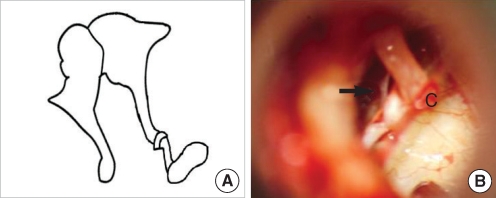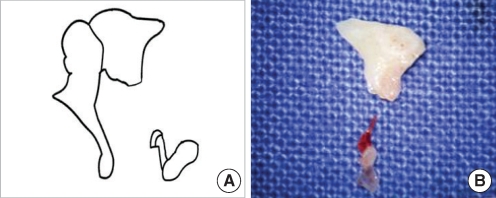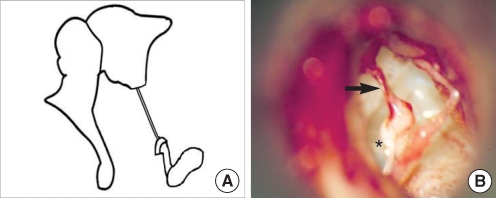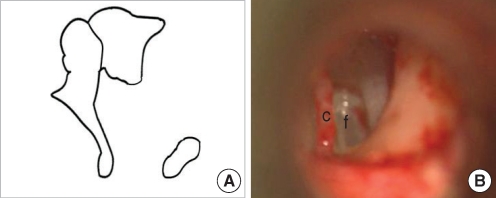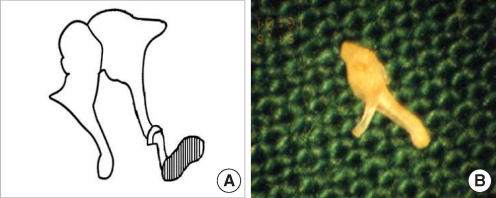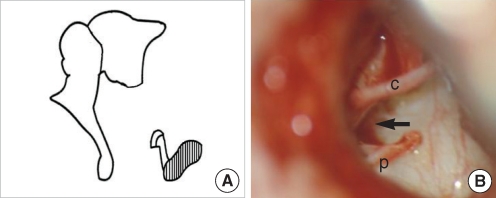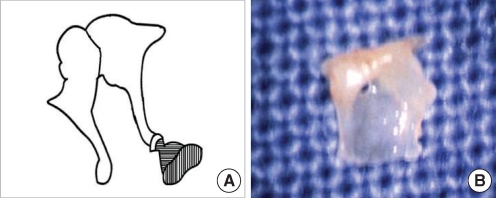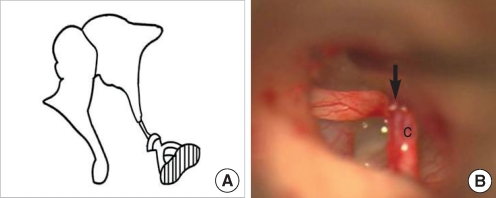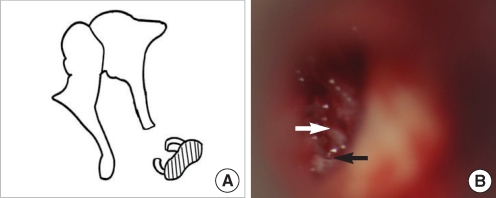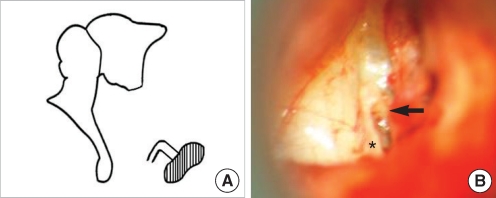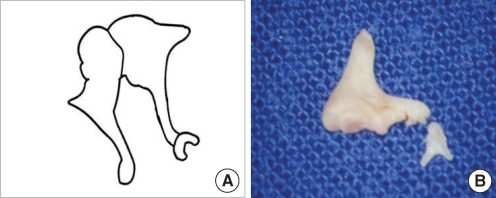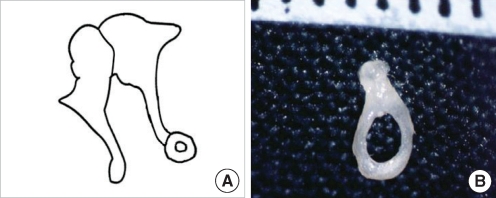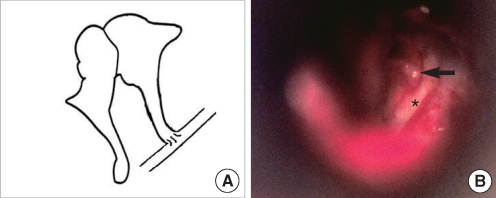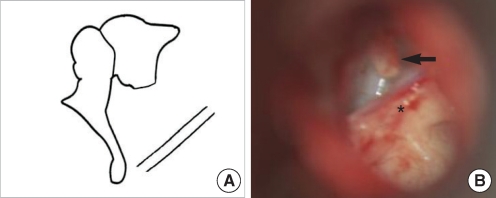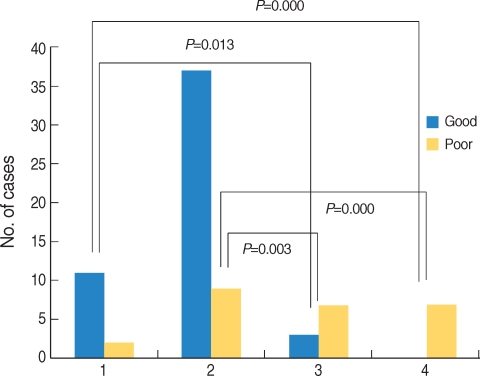Clin Exp Otorhinolaryngol.
2009 Mar;2(1):33-38. 10.3342/ceo.2009.2.1.33.
Congenital Stapes Anomalies with Normal Eardrum
- Affiliations
-
- 1Department of Otolaryngology, Ajou University School of Medicine, Suwon, Korea. parkkh@ajou.ac.kr
- KMID: 1466561
- DOI: http://doi.org/10.3342/ceo.2009.2.1.33
Abstract
OBJECTIVES
A non-progressive and conductive hearing loss with normal eardrum, but no history of trauma and infection, is highly suggestive of a congenital ossicular malformation. Among ossicular anomalies, stapes anomaly is the most common. The purpose of this study is to describe patterns of stapes anomaly and to analyze its surgical outcome with special reference to its patterns.
METHODS
We conducted a retrospective case review. The subjects comprised 66 patients (76 ears) who were decisively confirmed by the exploratory tympanotomy as congenital stapes anomalies without any anomalies of the tympanic membrane and external auditory canal. The preoperative and postoperative audiological findings, temporal bone computed tomography scan, and operative findings were analyzed.
RESULTS
There were 16 anomalous patterns of stapes among which footplate fixation was the most common anomaly. These 16 patterns were classified into 4 types according to the status of stapes footplate. Successful hearing gain was achieved in 51 out of 76 ears (67.1%) after surgical treatment.
CONCLUSION
Footplate fixation was usually bilateral, whereas stapes anomalies associated with other ossicular anomaly were usually unilateral. The success of the surgical treatment of stapes anomaly might depend on its developmental status of the footplate. Stapes anomalies were detected without any fixed patterns, therefore, it is quite possible to detect a large variety of patterns in future.
MeSH Terms
Figure
Reference
-
1. House HP, House WF, Hildyard VH. Congenital stapes footplate fixation: a preliminary report of twenty-three operated cases. Laryngoscope. 1958; 8. 68(8):1389–1402. PMID: 13576898.
Article2. Lindsay JR, Sanders SH, Nager GT. Histopathologic observations in so-called congenital fixation of the stapedial footplate. Laryngoscope. 1960; 12. 70(12):1587–1602. PMID: 13762396.
Article3. Gundersen T. Congenital malformations of the stapes footplate. Arch Otolaryngol. 1967; 2. 85(2):171–176. PMID: 6017589.
Article4. Steele BC. Congenital fixation of the stapes footplate. Acta Otolaryngol. 1969; (Suppl 245):1–24. PMID: 5379836.5. Teunissen B, Cremers WR, Huygen PL, Pouwels TP. Isolated congenital stapes ankylosis: surgical results in 32 ears and a review of the literature. Laryngoscope. 1990; 12. 100(12):1331–1336. PMID: 2243529.6. Nandapalan V, Tos M. Isolated congenital stapes ankylosis: an embryologic survey and literature review. Am J Otol. 2000; 1. 21(1):71–80. PMID: 10651438.
Article7. Albert S, Roger G, Rouillon I, Chauvin P, Denoyelle F, Derbez R, et al. Congenital stapes ankylosis: study of 28 cases and surgical results. Laryngoscope. 2006; 7. 116(7):1153–1157. PMID: 16826051.
Article8. Schlosser WD, Goldman BR, Winchester RA. Further experiences with the diagnosis and surgical management of congenital mixed deafness. Laryngoscope. 1964; 6. 74:773–789. PMID: 14171385.
Article9. Hashimoto S, Yamamoto Y, Satoh H, Takahashi S. Surgical treatment of 52 cases of auditory ossicular malformations. Auris Nasus Larynx. 2002; 1. 29(1):15–18. PMID: 11772485.
Article10. Committee on Hearing and Equilibrium. Committee on hearing and equilibrium guidelines for the evaluation of results of treatment of conductive hearing loss. Otolaryngol Head Neck Surg. 1995; 9. 113(3):186–187. PMID: 7675477.11. Dass R, Grewal BS, Thapar SP. Human stapes and its variations. II. Footplate. J Laryngol Otol. 1966; 5. 80(5):471–480. PMID: 5934111.12. Yuen HY, Ahuja AT, Wong KT, Yue V, van Hasselt AC. Computed tomography of common congenital lesions of the temporal bone. Clin Radiol. 2003; 9. 58(9):687–693. PMID: 12943639.
Article13. Raveh E, Hu W, Papsin BC, Forte V. Congenital conductive hearing loss. J Laryngol Otol. 2002; 2. 116(2):92–96. PMID: 11827579.
Article14. Hung KL, Tu TY, Tsai TL, Shiao AS. Congenital ossicular anomalies. J Chin Med Assoc. 2003; 8. 66(8):474–479. PMID: 14604311.15. Dornhoffer JL, Helms J, Hoehmann DH. Stapedectomy for congenital fixation of the stapes. Am J Otol. 1995; 5. 16(3):382–386. PMID: 8588635.16. Cremers CW, Hoogland GA. Congenital stapes ankylosis by elongation of the pyramidal eminence. Ann Otol Rhinol Laryngol. 1986; Mar–Apr. 95(2 Pt 1):167–168. PMID: 3963687.17. Teunissen B, Cremers CW. Surgery for congenital stapes ankylosis with an associated congenital ossicular chain anomaly. Int J Pediatr Otorhinolaryngol. 1991; 5. 21(3):217–226. PMID: 1869375.
Article18. Kinsella JB, Kerr AG. Familial stapes superstructure fixation. J Laryngol Otol. 1993; 1. 107(1):36–38. PMID: 8445310.
Article19. Nandapalan V, Tos M. Isolated congenital stapes suprastructure fixation. J Laryngol Otol. 1999; 9. 113(9):798–802. PMID: 10664680.
Article

